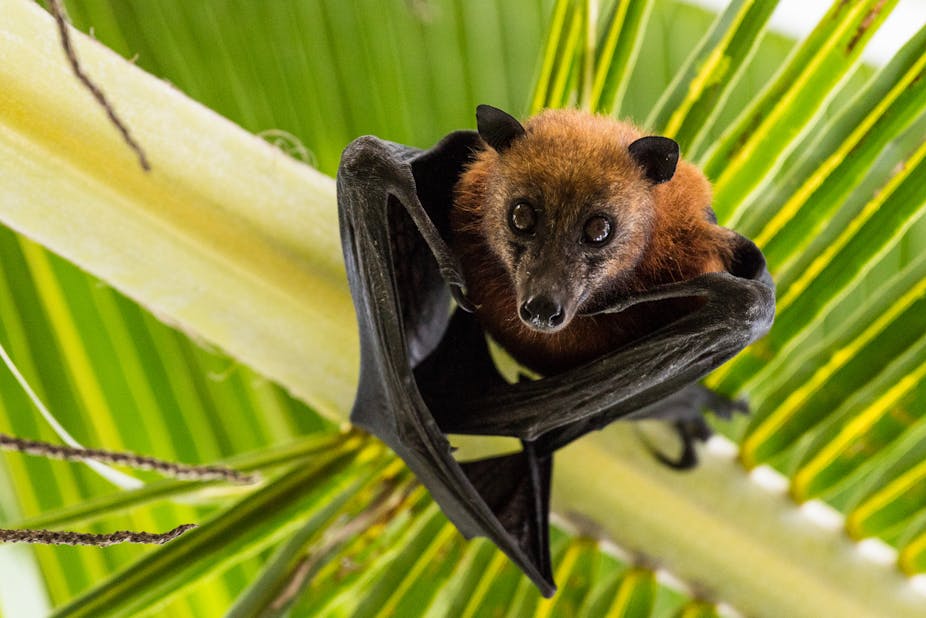Straw-coloured fruit bats exist throughout most of the African continent. This large fruit bat is one of, if not the most numerous fruit-eating animal (called frugivores) in Africa. They live in colonies of thousands to millions of individuals.
Fruit bats sleep during the day, hanging upside down in the crowns of old trees, and become active at sunset when they set off in search of food – specifically nectar and fruit.
With their wingspan of up to 80cm, they are able to cover vast distances. When the colonies are very large and competition for food is stiff, they can fly up to 95km to suitable food trees and only return to their roosts the following morning. They defecate the seeds of the fruit they eat over an unusually long time period, even during flight. They can thus disperse seeds across huge areas as they go.
The seeds transported in this way can end up far from the parent plant, and in areas that are good for germination and establishment. The fact that these gigantic colonies seasonally migrate across Africa, following the rain and upcoming fruit, help disperse seeds of seasonal fruit and in places with only a few local frugivores.
The fruit bats therefore contribute to the species and genetic diversity of forests.
In 2019 we investigated the potential of these fruit bat colonies to reforest areas where trees had been lost in parts of Africa.
We tracked the movements of fruit bats in Ghana, Burkina Faso and Zambia by deploying them with small GPS loggers, which allowed us to follow their nightly movements to food trees. We also looked into how long they held food in their gut. We then applied our findings to entire colonies to see what services they provided in large numbers.
We found that, in a conservative estimate, a colony of 150,000 animals could disseminate more than 300,000 small seeds in a single night, and that a single colony of fruit bats could kickstart the regrowth of 800 hectares of forest.

They’ve likely often done so – a study using seed traps deforested areas in Cote d'Ivoire found that 96% of dropped seeds were carried in by fruit bats.
Worryingly, fruit bats have started to disappear from forests everywhere. They are primarily at risk from hunting and persecution out of superstition, fear or simple annoyance due to the noise they make when they roost.
This would not only lead to a loss in biodiversity but have huge economic consequences as fruit bats disperse the seeds of, and likely pollinate as well, many economically valuable plants such as timber species and food producing plants.
Spreading seeds
For our study, we used GPS transmitters to track the flight paths of the bats. We also measured the time it took them to excrete the seeds after eating them. For this we took bats into captivity, fed them their natural food dyed with fluorescent dye and then filmed when which food item was excreted. These showed that the animals only excrete some of the seeds after a relatively long time, thereby facilitating their dispersal over vast distances.
We were able to calculate the potential of an entire colony to disseminate seeds over long distances and to transport them to deforested areas.
Among other things, the straw-coloured fruit bat disperses fast-growing trees that are the first to colonise open ground, so-called pioneer trees, and which are able to grow in bright sunlight, creating the right environment for rainforest tree species to establish and grow.
The profit that the regrowth of this much forest generates for the population, for example through edible fruits, increased soil fertility and timber, has been estimated using the results from a study on the cost of deforestation in Ghana under the assumption that all areas supplied with seeds by bats were allowed to reforest. Our estimate was in excess of 700,000 Euro (about US$750,000). Because the straw-coloured fruit bats migrate throughout Africa, many communities profit from their services.
In decline
Sadly, the population of straw-coloured fruits bats is in continuous decline. For example a colony we monitor in Accra, Ghana, has gone down from one million individuals over a decade ago to less than 20,000 bats in the spring of 2022.
Given that each female gives birth to a single pup each year, this is going to lead to a population collapse. Logging the large trees in which the animals live is also threatening their populations. Often we will return to a place where a thriving colony was previously observed only to find their roost trees and thus the bats, gone.
The straw-coloured fruit bats contribute to the conservation of African forests, so there is an urgent need to explain their importance to the human population. With the recent COVID-outbreak and other diseases such as Ebola, bats have moved into the focus of the press and thus local communities. While it is important to inform people about how to safely co-exist with the bats, there is currently no scientific evidence to support the rumour that straw-coloured fruit bats or any bat may have been involved in these outbreaks. The best way to ensure the health and safety of both bats and people is to simply stay away from them.
During our research, we met a local king in Kibi, a town in southern Ghana, who is leading by example. He’s placed the straw-coloured fruit bat colony that has taken up residence in his garden under his own personal protection and calls them their babies.
An NGO we collaborate with closely – the Rwanda Wildlife Corporation – does exemplary work to help mitigate the negative trend of fruit bat populations. They visit local communities, inform them about the benefits and threats the bats offer, and recruit local volunteers to contribute to counts and observations. Many of these volunteers are children, which are our best ambassadors for a future where humans and bats can live side by side.

